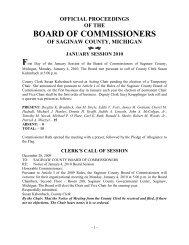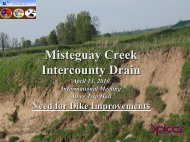The Metropolitan Transportation Planning ... - Saginaw County
The Metropolitan Transportation Planning ... - Saginaw County
The Metropolitan Transportation Planning ... - Saginaw County
You also want an ePaper? Increase the reach of your titles
YUMPU automatically turns print PDFs into web optimized ePapers that Google loves.
<strong>The</strong> <strong>Metropolitan</strong> <strong>Transportation</strong> <strong>Planning</strong> Process: Key Issues<br />
<strong>Metropolitan</strong> <strong>Planning</strong> Organization<br />
(MPO)<br />
<strong>Metropolitan</strong> <strong>Transportation</strong> Plan (MTP)<br />
Mobile Source<br />
Mode<br />
Regional policy body, required in urbanized<br />
areas with populations over 50,000, and<br />
designated by local officials and the<br />
governor of the state. Responsible in<br />
cooperation with the state and other<br />
transportation providers for carrying out the<br />
metropolitan transportation planning<br />
requirements of federal highway and transit<br />
legislation.<br />
<strong>The</strong> official intermodal transportation plan<br />
that is developed and adopted through<br />
the metropolitan transportation planning<br />
process for the metropolitan planning area,<br />
in accordance with 23 U.S.C. 134, 23 U.S.C.<br />
135 and 49 U.S.C. 5303.<br />
Mobile sources include motor vehicles,<br />
aircraft, seagoing vessels, and other<br />
transportation modes. <strong>The</strong> mobile sourcerelated<br />
pollutants are carbon monoxide<br />
(CO), hydrocarbons (HC), nitrogen oxides<br />
(NOx), and particulate matter (PM-10 and<br />
PM 2.5).<br />
A specific form of transportation, such as<br />
automobile, subway, bus, rail, or air.<br />
N<br />
National Ambient Air Quality Standards<br />
(NAAQS)<br />
National Environmental Policy Act of<br />
1969 (NEPA)<br />
National ITS Architecture<br />
Nonattainment<br />
Federal standards that set allowable<br />
concentrations and exposure limits for<br />
various pollutants. <strong>The</strong> EPA developed the<br />
standards in response to a requirement of<br />
the CAA. Air quality standards have been<br />
established for the following six criteria<br />
pollutants: ozone (or smog), carbon<br />
monoxide, particulate matter, nitrogen<br />
dioxide, lead, and sulfur dioxide.<br />
Established a national environmental policy<br />
requiring that any project using federal<br />
funding or requiring federal approval,<br />
including transportation projects, examine<br />
the effects of proposed and alternative<br />
choices on the environment before a<br />
federal decision is made.<br />
A systems framework to guide the planning<br />
and deployment of ITS infrastructure. <strong>The</strong><br />
national ITS architecture is a blueprint for<br />
the coordinated development of ITS<br />
technologies in the U.S. It is unlikely that any<br />
single metropolitan area or state would<br />
plan to implement the entire national ITS<br />
architecture.<br />
A geographic region of the United States<br />
that the EPA has designated as not<br />
meeting the air quality standards.<br />
O



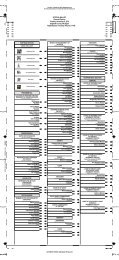
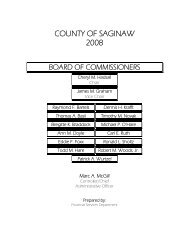
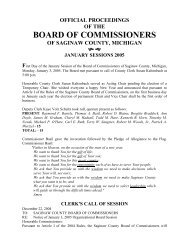
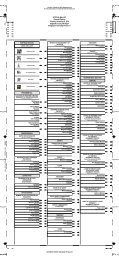

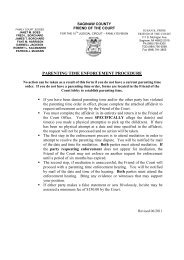
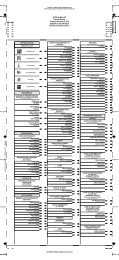


![[ Of Commissioners] - Saginaw County](https://img.yumpu.com/25951211/1/190x245/-of-commissioners-saginaw-county.jpg?quality=85)


